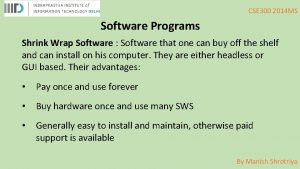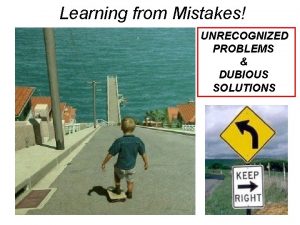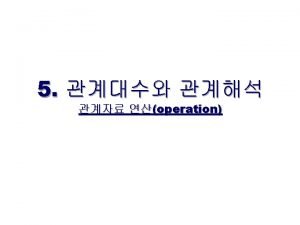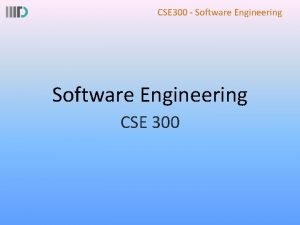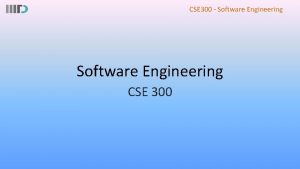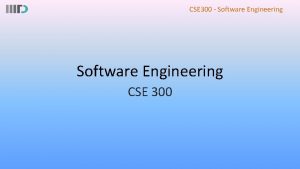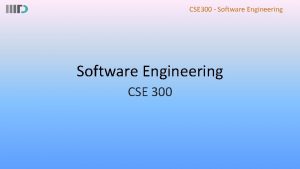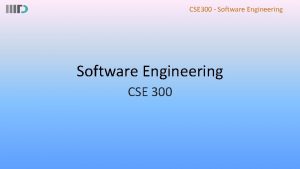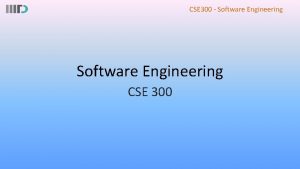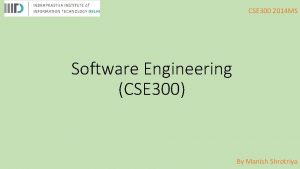CSE 300 2014 MS Software Programs Shrink Wrap














- Slides: 14

CSE 300 2014 MS Software Programs Shrink Wrap Software : Software that one can buy off the shelf and can install on his computer. They are either headless or GUI based. Their advantages: • Pay once and use forever • Buy hardware once and use many SWS • Generally easy to install and maintain, otherwise paid support is available By Manish Shrotriya

CSE 300 2014 MS Software Programs in Internet age Shrink Wrap Software and changes: Till there was no internet, growth of hardware and consequently growth of software resulted in drastic reduction of software usability. Advent of internet: Internet brought a new concept to everyone’s door step. One can get a resource/information that is located in different geography. Initially these recourses were simple piece of information available for masses. Growth of browser based mail brought the concept of personal data stored remotely and presented in different format when requested. By Manish Shrotriya

CSE 300 2014 MS Software Programs in Internet age Browser based mail gave paved path for Client Server based topology. It existed before internet too but limited to research institute. Internet brought this concepts to masses. Advantages: • Exponential growth of free information to every one. • Invention of communication software like chat, conference software, desktop sharing. • Concept of online shopping, banking • Huge socio-economic growth By Manish Shrotriya

CSE 300 2014 MS Software Programs in Internet age Architectural changes: Single machine (PC based) Browsers/ client Remote Server Application engine Software 1 DB Storage OS File system By Manish Shrotriya

Software Programs in Internet age CSE 300 2014 MS Architectural changes: Simple Layered Server in Client Sever paradigm to Service Based due to complexity Remote Server Application engine DB Storage Remote Server Application engine Service 1 Service 2 Service 3 DB DB DB By Manish Shrotriya

CSE 300 2014 MS Software Programs in Internet age disadvantage Cost issues: • Drastic reduction of software’s usable life( both SWS and C/S) due to frequent upgrade, new technologies • Reduction of hardware life changed one time investment into recurring investment. • Maintenance cost has increased exponentially for both consumers and organizations. Security: With the dawn of malicious software, privacy and security became big concern for data stored locally and remotely as well. By Manish Shrotriya

CSE 300 2014 MS Software as Service and Platform and Service Due to cost and security organizations came up with offering of software and hardware as service. It is popularly known as cloud computing. Advantages: • Consumers can choose different vendor at will • Pay only when it is used, only for what is used, means reduced cost • No need of high end hardware at consumer side, means increase life of existing hardware. • No SWS at consumer side means no maintenance cost. • Need of security and expertise became concentrated with SAAS vendors only. By Manish Shrotriya

CSE 300 2014 MS Software as Service and Platform and Service Advantages: • Even for organization that are operating in Server side in C/S based structure, no maintenance cost, no high end hardware cost. They could concentrate their limited resources only on the business function they are catering too. • Hardware offering became “elastic”. Consumer organizations can demand more hardware based on seasonal pressure on their business and return it once season is over. By Manish Shrotriya

CSE 300 2014 MS Cloud Computing in Details From: Cloud Computing Principles and Paradigms By Manish Shrotriya

Cloud Computing in Details CSE 300 2014 MS From: Cloud Computing Principles and Paradigms By Manish Shrotriya

CSE 300 2014 MS Feature of Cloud computing Self Service: Consumers of cloud computing services expect ondemand, nearly instant access to resources. To support this expectation, clouds must allow self-service access so that customers can request, customize, pay, and use services without intervention of human operators. Per-Usage Metering and Billing: Cloud computing eliminates upfront commitment by users, allowing them to request and use only the necessary amount. Services must be priced on a short term basis (e. g. , by the hour), allowing users to release (and not pay for) resources as soon as they are not needed By Manish Shrotriya

CSE 300 2014 MS Feature of Cloud computing Elasticity: Users expect clouds to rapidly provide resources in any quantity at any time. In particular, it is expected that the additional resources can be provided, possibly automatically, when an application load increases and released when load decreases. Customization: In a public cloud, different users pose different requirement. Thus, resources rented from the cloud must be highly customizable. In the case of infrastructure services, customization means allowing users to deploy specialized virtual appliances and to be given admin access to the virtual servers. It could mean different OS and different development technology platforms. By Manish Shrotriya

CSE 300 2014 MS Best Practices of Cloud computing Fail-safe Design: Assume that thing will fail, application would crash hardware would fail. Then design automated detection and recovery. loosely coupled Components: loose coupling isolates the various layers and components of your application so that each component interacts asynchronously with the others and treats them as a “black box. ” Elasticity: Proactive(scheduled) Cyclic Scaling, Proactive Event-Based Scaling, Auto-scaling Based on Demand(monitoring based). By Manish Shrotriya

CSE 300 2014 MS Best Practices of Cloud computing Think Parallel: Do things parallel as much as possible be it storing data, catering computing requests, retrieving data. Data type and location: Keep Dynamic Data Closer to the Compute and Static Data Closer to the End User Protect Your Data in Transit. HTTPS, Authentication and Encryption Protect your Data at Rest: Encrypted storage. File encryption or HD encryption. By Manish Shrotriya
